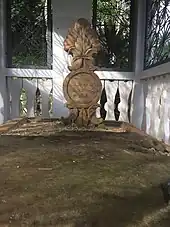| Omar Ali Saifuddin I | |||||||||
|---|---|---|---|---|---|---|---|---|---|
| Sultan of Brunei | |||||||||
| Reign | 1740–1778[1] | ||||||||
| Predecessor | Muhammad Alauddin | ||||||||
| Successor | Muhammad Tajuddin | ||||||||
| Born | Omar Ali Saifuddin | ||||||||
| Died | 10 July 1795 | ||||||||
| Burial | |||||||||
| Spouse | Pengiran Anak Puteri Pengiran Anak Nor Alam Pengiran Anak Bongsu Wan Puteh | ||||||||
| Issue Detail | Sultan Muhammad Tajuddin Sultan Muhammad Kanzul Alam | ||||||||
| |||||||||
| House | Bolkiah | ||||||||
| Father | Muhammad Alauddin | ||||||||
| Mother | Pengiran Anak Sharbanun | ||||||||
| Religion | Sunni Islam | ||||||||
Omar Ali Saifuddin I ibni Muhammad Alauddin (Jawi: عمر علي سيف الدين١; died 10 July 1795), also known as Al-Marhum Makam Besar, was the 18th Sultan of Brunei and the second son of Sultan Muhammad Alauddin. He was regarded as one of the longest-serving sultans and was renowned for his wise leadership and just rule, merely following his father-in-law, Sultan Hussin Kamaluddin. In fact, he received helpful knowledge, counsel, and experience from his father-in-law when he was still alive during his reigning period.[2]
Reign
Succession
Sultan Hussin Kamaluddin subsequently gave Pengiran Muda Tengah Omar Ali Saifuddin the sultanate of Brunei. In 1740, Pengiran Muda Tengah Omar Ali Saifuddin assumed the title of Sultan Omar Ali Saifuddin I.[3] According to Sir Hugh Low, the new Sultan was still very young when he ascended the throne. It appears that the restoration go the Bendahara line and the end of the so-called legitimate or usurper rule coincided with the ascension to the throne of Sultan Omar Ali Saifuddin I. On the other hand, Spanish accounts claimed that the deceased Sultan obviously had no legal son, whereas Brunei sources Sisilah Raja-Raja Brunei and Batu Tarsilah assert that Sultan Omar Ali Saifuddin I was the heir.[4]
Manila conflict
After Sultan Omar Ali Saifuddin learned about the situation in Manila of the Philippines, due to it being Bruneian territory, he was not pleased. As a result, he gave command to attack Sultan Alimuddin in Manila with his forces under the command of Pehin Orang Kaya Di-Gadong Seri Lela Awang Aliwaddin in 1769.[5] The mission didn't arrive in Manila until 1769 because the expedition's preparations took so long. Sultan Alimuddin had already departed Manila for Sulu, therefore Manila was under Spanish rule when the siege began.[6] The siege would go on to be a success as Manila was captured by the Brunei sultanate.[7]
Sabah conflict
The conflict over North Borneo, also known as Sabah, began after which a promise made by Sultan Muhyiddin to the Sultan of Sulu after Sulu helped him win the Brunei Civil War that went in his favor. Sulu attacked Brunei in 1771 after he had become severely weakened. Sultan Omar Ali Saifuddin signed a deal with the British Empire in June 1774 to secure outside support. The British were looking for a storehouse along the way to Canton and received exclusive rights to the pepper trade in exchange for their military assistance.[8] When Sulu despatch a force under the command of Datu Teting to attack Balambangan in 1775, its leaders sought safety in Labuan after the British quickly established a presence in Brunei.[8] When the two forces clashed, Datu Teting surrendered and his troops fled back to Sulu after learning that the warriors of Brunei, led by Pengiran Temenggong Ampa, were far too strong for them to defeat.[9][2] Thomas Forrest visited Brunei in February 1776.[5] Despite Labuan's offer, the British left Brunei in 1777 due to the financial collapse of Balambangan, losing the entire East India Company.[8][10]
Abdication

Sultan Omar Ali Saifuddin I ruled until the year 1778. He abdicated his position in favour of his son, Pengiran Muda Besar Muhammad Tajuddin, later known as Sultan Muhammad Tajuddin, being the heir.[3][11]
After death, he was buried at the Kubah Makam Di Raja in Bandar Seri Begawan.
Personal life
Sultan Omar Ali Saifuddin was married three times, three out of his four wives were Sultan Husin Kamaluddin's daughters; Pengiran Anak Putri, Pengiran Anak Nur Alam, Pengiran Istri Bongsu and Wan Puteh. Known children of Omar Ali were:
- Sultan Muhammad Tajuddin
- Sultan Muhammad Khanzul Alam
- Pangiran Anak Abdul Wahab
- Pangiran Anak Sulaiman
- Pangiran Anak Usuf
References
- ↑ "Sejarah Sultan-Sultan Brunei" (PDF). Hmjubliemas.gov.bn. Archived (PDF) from the original on 31 January 2018. Retrieved 3 February 2018.
- 1 2 History, Borneo (29 December 2014). "Borneo History: Sultan Omar Ali Saifuddien I". Borneo History. Retrieved 7 April 2023.
- 1 2 "Kesultanan Brunei Darussalam | Kerajaan Nusantara". www.kerajaannusantara.com. Retrieved 7 April 2023.
- ↑ Gin, Ooi Keat (14 December 2015). Brunei - History, Islam, Society and Contemporary Issues. Routledge. p. 4. ISBN 978-1-317-65998-3.
- 1 2 Masa silam sarana masa depan: kumpulan kertas kerja Seminar Sejarah Brunei II (in Malay). Jabatan Pusat Sejarah, Kementerian Kebudayaan, Belia dan Sukan. 1999. p. 18. ISBN 978-99917-34-16-3.
- ↑ al-Sufri (Haji), Awang Mohd Jamil (2002). Survival of Brunei: A Historical Perspective. Brunei History Centre, Ministry of Culture, Youth and Sports. p. 36. ISBN 978-99917-34-18-7.
- ↑ 50 Years Historical Moments of Omar Ali Saifuddien Mosque, 1958-2008 (in Malay). Ministry of Religious Affairs, Negara Brunei Darussalam. 2008. p. 68. ISBN 978-99917-922-0-0.
- 1 2 3 Vienne, Marie-Sybille de (9 March 2015). Brunei: From the Age of Commerce to the 21st Century. NUS Press. p. 74. ISBN 978-9971-69-818-8.
- ↑ "Pusat Sejarah Brunei - Sultan - Sultan Brunei". www.history-centre.gov.bn. Retrieved 7 April 2023.
- ↑ al-Sufri (Haji), Awang Mohd Jamil (2002). Survival of Brunei: A Historical Perspective. Brunei History Centre, Ministry of Culture, Youth and Sports. p. 37. ISBN 978-99917-34-18-7.
- ↑ Borneo Bulletin Brunei Yearbook. Brunei Press Sdn. Bhd. in collaboration with Integrated Information Pte. Limited. 2007. pp. E-90.
